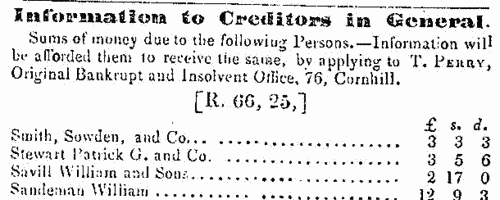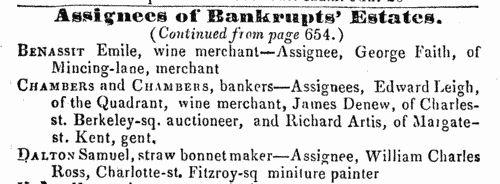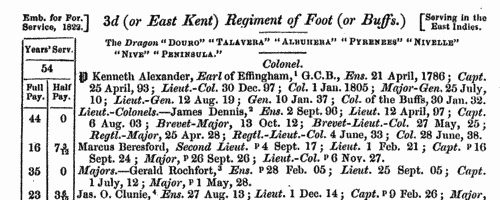Our indexes include entries for the spelling hickson. In the period you have requested, we have the following 493 records (displaying 211 to 220):
Bankruptcy information
(1839)
Abstract of the circumstances causing a bankruptcy in England and Wales: assets, liabilities &c. | Sample scan, click to enlarge

|
Insolvents
(1839)
Insolvency notices for England and Wales: insolvency often caused people to restart their lives elsewhere, so these are an important source for lost links | Sample scan, click to enlarge

|
Insolvents
(1839)
Insolvency notices for England and Wales: insolvency often caused people to restart their lives elsewhere, so these are an important source for lost links | Sample scan, click to enlarge

|
Subscribers to Memoir of Thomas Cranfield by his Son
(1839)
The memoir of the life of Thomas Cranfield 'is a standing memorial of the blessed effects which result from the enlightened zeal and Christian perseverance of one man, in the cause of the dear Redeemer.' He was 'a laborious Sabbath-school Teacher; long a beloved Leader in the Southwark Sunday-school Society, and the devotedly-benevolent Visitor of the poor outcasts in the Mint and surrounding courts and alleys' on behalf of Surrey Chapel in Southwark; he was born 12 March 1758 in Southwark and died there 28 November 1838. This account of his life by his son attracted a wide subscription, particularly in London. The subscription list gives names and addresses, and in cases where multiple copies were ordered, says so. | Sample scan, click to enlarge

|
Bankrupts' Assignees
(1840)
Assignees of bankrupts' estates (usually principal creditors and/or close relatives of the bankrupt) in England and Wales | Sample scan, click to enlarge

|
Electors of Emneth
(1840)
The register of electors entitled to vote in any parliamentary election for West Norfolk between 1 November 1840 and 1 November 1841 lists 7,620 freeholders arranged by hundred and within hundred by parish or township &c. In the first column, after number within the register, the elector's name is given (surname first); the second column gives place of abode; the third column the nature of qualification (such as 'owner and occupier'); and the fourth column the address of the qualifying property, in some cases with the name of the tenant or occupier. | Sample scan, click to enlarge

|
Insolvents
(1840)
Insolvency notices for England and Wales: insolvency often caused people to restart their lives elsewhere, so these are an important source for lost links | Sample scan, click to enlarge

|
Officers of the British Army
(1840)
The New Annual Army List, corrected to 7 February 1840, was published in London by Lieut. H. G. Hart. It lists all serving officers, first of all a list of General and Field Officers by rank from field marshal down to major; and then by regiment, including all ranks down to ensign, with paymasters, adjutants, quarter-masters, surgeons and assistant-surgeons. These lists are all annotated with dates of rank in the army and regiment, and with symbols indicating the officers present at Trafalgar (T), in the Peninsula or the South of France (P), and Waterloo (W). A superscript p indicates that the commission was purchased; an asterisk that it was temporary. The regiments and units are listed in order of precedence: Head Quarters staff; Life Guards; Horse Guards; 7 regiments of Dragoon Guards; 17 regiments of Dragoons; 98 regiments of Foot; the Rifle Brigade; two West India regiments of Foot; Ceylon Rifles; Royal African Colonial Corps; Cape Mounted Rifles; Royal Newfoundland Veterans; Royal Malta Fencibles; Recruiting Staff; Royal Artillery; Royal Engineers; Royal Marines; Commissariat; and the Medical Department. | Sample scan, click to enlarge

|
 Outstanding British artillerymen
(1840) Outstanding British artillerymen
(1840)
Non-commissioned officers and men of the Royal Artillery discharged and recommended for medals and gratuities. The lists state rank, name, battalion or corps, and length of service (in years and months). The good conduct medals were at this period by no means issued automatically: only outstanding soldiers were recommended. The lists themselves are lists of recommendations, not necessarily of award of medal and/or gratuity, though in most cases the award would naturally follow. Where an award was not made, the reason is usually given. Where a man's name is crossed through it should not be assumed that he was deleted from the list: sometimes the name is crossed through when the medal has been dispatched. (The sample scan is from 1847, by which time details of foreign service had been added to the format) | Sample scan, click to enlarge

|
Tenants and occupiers in Walsoken
(1840)
The register of electors entitled to vote in any parliamentary election for West Norfolk between 1 November 1840 and 1 November 1841 lists 7,620 freeholders arranged by hundred and within hundred by parish or township &c. In the first column, after number within the register, the elector's name is given (surname first); the second column gives place of abode; the third column the nature of qualification (such as 'owner and occupier'); and the fourth column the address of the qualifying property, in some cases with the name of the tenant or occupier. | Sample scan, click to enlarge

|
Research your ancestry, family history, genealogy and one-name study by direct access to original records and archives indexed by surname.












